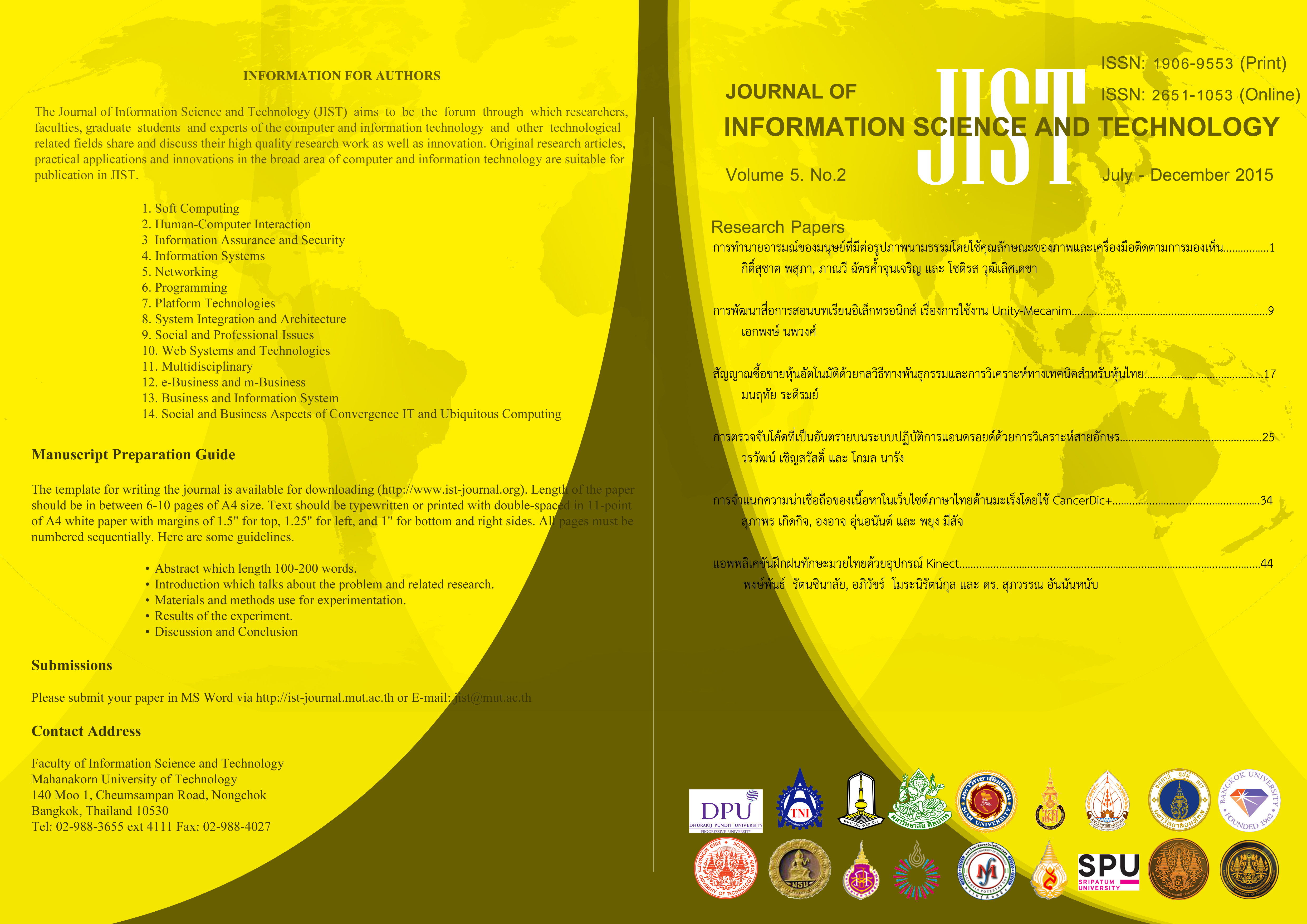The Development of E-Learning Courseware of Unity-Mecanim
Main Article Content
Abstract
- This research aims to develop E-Learning courseware for Special topic in Computer Games and Multimedia on Unity-Mecanim Application course, study the learning achievement and evaluate the satisfaction of the students after using this E-Learning courseware. The sample of this research is seven students who enrolled in CGM499: Special topic in Computer Games and Multimedia on Unity-Mecanim Application course in the first semester of 2014. This E-Learning courseware was developed using Adobe Captivate 7.0 and divided into six chapters. Each chapter consists of Pre-test, Learning Contents, and Post-Test. The results showed that the contents and the presentation of this E-Learning courseware fulfilled the needs of the students and this E-Learning courseware could be used as the teaching materials inside the classroom or self-learning materials outside the classroom.
Article Details
This work is licensed under a Creative Commons Attribution-NonCommercial-NoDerivatives 4.0 International License.
I/we certify that I/we have participated sufficiently in the intellectual content, conception and design of this work or the analysis and interpretation of the data (when applicable), as well as the writing of the manuscript, to take public responsibility for it and have agreed to have my/our name listed as a contributor. I/we believe the manuscript represents valid work. Neither this manuscript nor one with substantially similar content under my/our authorship has been published or is being considered for publication elsewhere, except as described in the covering letter. I/we certify that all the data collected during the study is presented in this manuscript and no data from the study has been or will be published separately. I/we attest that, if requested by the editors, I/we will provide the data/information or will cooperate fully in obtaining and providing the data/information on which the manuscript is based, for examination by the editors or their assignees. Financial interests, direct or indirect, that exist or may be perceived to exist for individual contributors in connection with the content of this paper have been disclosed in the cover letter. Sources of outside support of the project are named in the cover letter.
I/We hereby transfer(s), assign(s), or otherwise convey(s) all copyright ownership, including any and all rights incidental thereto, exclusively to the Journal, in the event that such work is published by the Journal. The Journal shall own the work, including 1) copyright; 2) the right to grant permission to republish the article in whole or in part, with or without fee; 3) the right to produce preprints or reprints and translate into languages other than English for sale or free distribution; and 4) the right to republish the work in a collection of articles in any other mechanical or electronic format.
We give the rights to the corresponding author to make necessary changes as per the request of the journal, do the rest of the correspondence on our behalf and he/she will act as the guarantor for the manuscript on our behalf.
All persons who have made substantial contributions to the work reported in the manuscript, but who are not contributors, are named in the Acknowledgment and have given me/us their written permission to be named. If I/we do not include an Acknowledgment that means I/we have not received substantial contributions from non-contributors and no contributor has been omitted.
References
2. S. Hubackova, “Evolution and evaluation of e-Learning,” ELSEVIER:Procedia-Social and Behavioural Sciences, p.231-235, 2015.
3. A. Thorn, “Foundations of Game Development:Game Engine Design and Implementation,” Jones&Bartlett Learning, 2011.
4. Clark, Ruth C., and Richard E. Mayer. “E-learning and the science of instruction: Proven guidelines for consumers and designers of multimedia learning,” John Wiley & Sons, 2011.
5. Garrison, D. Randy, “E-learning in the 21st century: A framework for research and practice,” Taylor & Francis, 2011.
6. Horton, William. E-learning by design. John Wiley & Sons, 2011.
7. Venkataraman, Sivakumar, and S. Sivakumar. "Engaging students in Group based Learning through e-learning techniques in Higher Education System," International Journal of Emerging Trends in Science and Technology, 2015.
8. Ong,C.S.,Lai,J.Y.,and Wang,Y,S., “Factors affecting engineers’ acceptance of asynchronous E-learning systems in high-tech companies,” Information & Management,41(6),795-804, p.01,2004.
9. Mona Nasr, Shimaa Ouf, An Ecosystem in e-Learning Using Cloud Computing as platform and Web2.0, The Research Bulletin of Jordan ACM – ISWSA,2011.
10. Laurillard , Diana, “E-learning in Higher Education”. Retrieved on May 22, 2015, from www.griffith.edu.au/03/Itn/docs/Elearning_in_Higher_Education.doc.
11. Jeff Ward, “What is a Game Engine?”. Retrieved on May 12, 2015, from http://www.gamecareerguide.com/features/529/what_is_a_game_.php
12. Eike Falk Anderson, Steffen Engel, etc. “The Case for Research in Game Engine Architecture”. 08 Proceedings of the 2008 Conference on Future Play, 2008.
13. Michal Valient. “3D Engines in games – Introduction”. HTML article written in April 2001.



